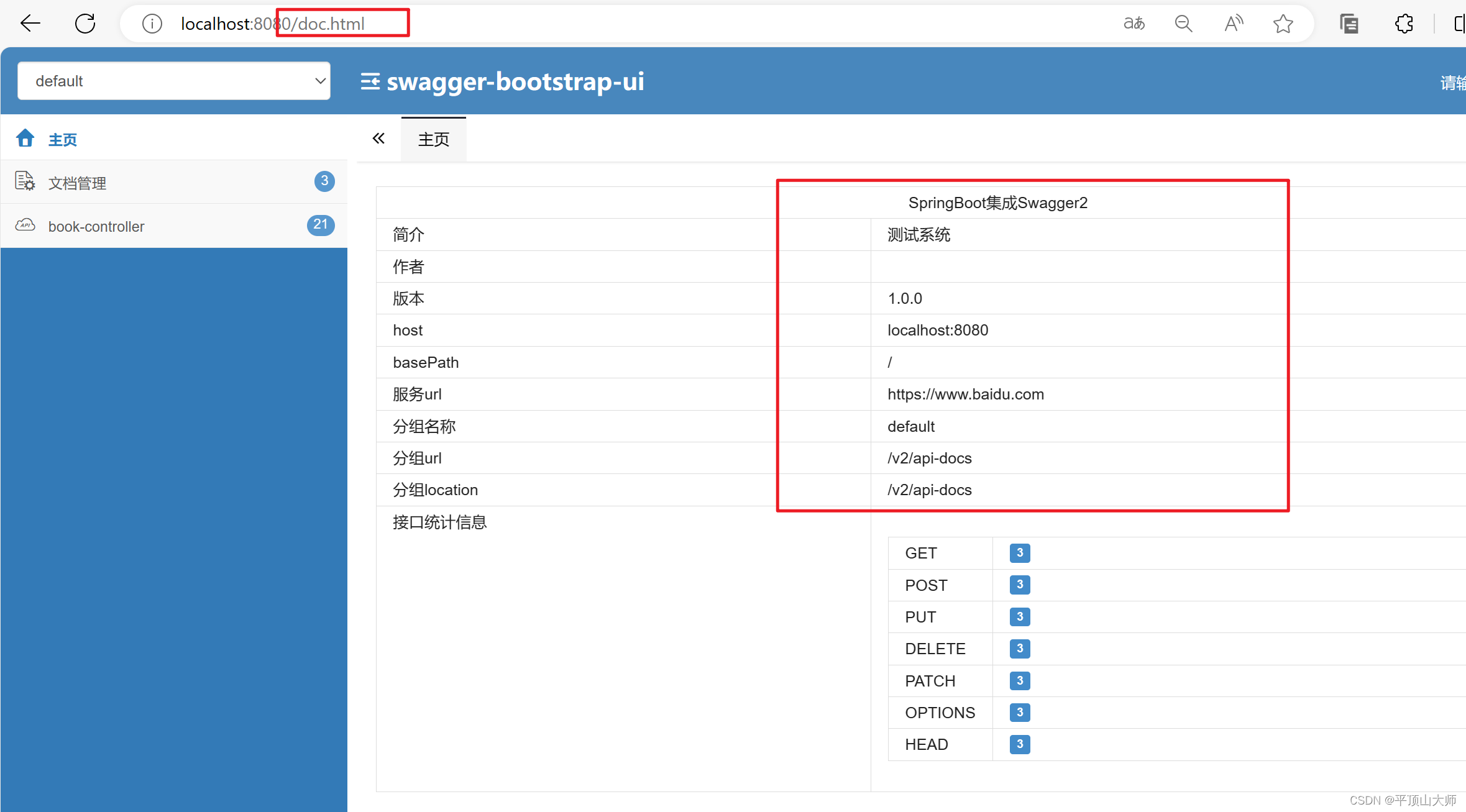Swagger2之SpringBoot集成使用

前言:
? ? ? 我们对于Mybatis-Plus的分享较多,都是接触的一些数据库相关的知识,今天给大家带来的是Swagger2
Swagger2
1.介绍:
Swagger2是一个规范和完整的框架,用于生成、描述、调用和可视化Restful风格的web服务,现在我们使用spring boot 整合它。作用:
- 接口的文档在线自动生成;
- 功能测试;
2.特点:
在线 API 文档可视化:
Swagger2 提供了一个基于 Web 的可视化界面,使得开发人员和其他团队成员能够轻松查看和理解 API 的结构和功能。这个界面允许用户直接在浏览器中测试 API,了解每个接口的请求和响应格式,并提供了交互式的方式来探索和理解 API 的功能。
功能测试:Swagger2 不仅提供了 API 文档的生成和可视化,还可以通过界面上提供的测试功能进行功能测试。开发人员可以在 Swagger2 的界面上直接调用 API 接口,观察返回结果,确保每个接口按照预期工作。这样可以在开发阶段及时发现和修复问题。
与 Spring Boot 整合:Swagger2 可以很容易地与 Spring Boot 集成。通过添加相应的依赖和配置,Swagger2 可以自动扫描项目中的 API,并生成相应的文档。Spring Boot 的注解与 Swagger2 的注解可以很好地配合,使得整合变得非常简单。
?
3.常用注解
| 注解 | 描述 |
|---|---|
| @Api | 将类标记为 Swagger 资源。 |
| @ApiImplicitParam | 表示 API 操作中的单个参数。 |
| @ApiImplicitParams | 允许多个 ApiImplicitParam 对象列表的包装器。 |
| @ApiModel | 提供有关 Swagger 模型的其他信息。 |
| @ApiModelProperty | 添加和操作模型属性的数据。 |
| @ApiOperation | 描述针对特定路径的操作或通常是 HTTP 方法。 |
| @ApiParam | 为操作参数添加额外的元数据。 |
| @ApiResponse | 描述操作的可能响应。 |
| @ApiResponses | 允许多个 ApiResponse 对象列表的包装器。 |
| @Authorization | 声明要在资源或操作上使用的授权方案。 |
| @AuthorizationScope | 描述 OAuth2 授权范围。 |
三、SpringBoot整合Swagger2
1. 导入pom依赖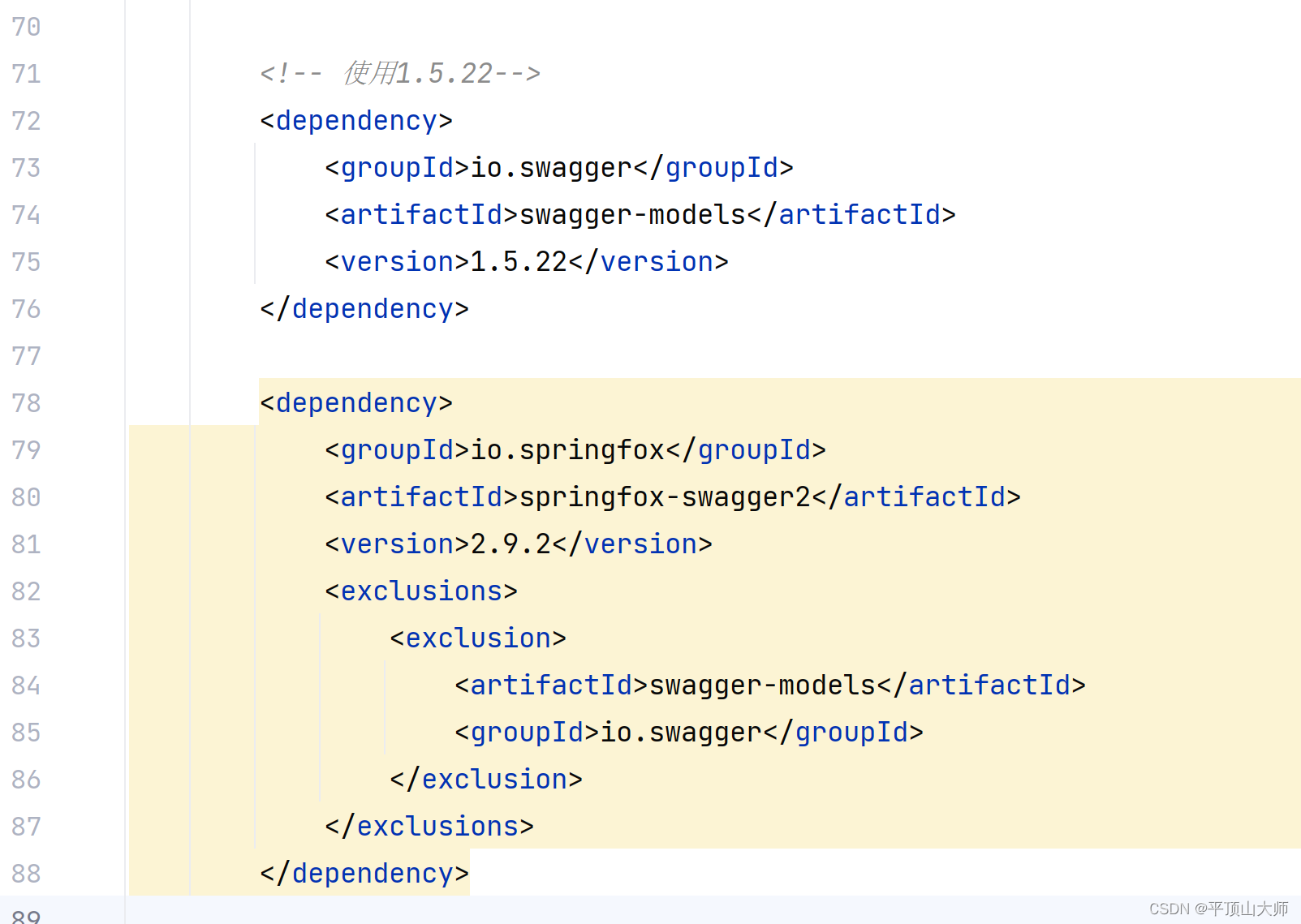
<dependency> <groupId>com.github.xiaoymin</groupId> <artifactId>swagger-bootstrap-ui</artifactId> <version>1.8.5</version> </dependency> <!-- 使用1.5.22--> <dependency> <groupId>io.swagger</groupId> <artifactId>swagger-models</artifactId> <version>1.5.22</version> </dependency> <dependency> <groupId>io.springfox</groupId> <artifactId>springfox-swagger2</artifactId> <version>2.9.2</version> <exclusions> <exclusion> <artifactId>swagger-models</artifactId> <groupId>io.swagger</groupId> </exclusion> </exclusions> </dependency>
2. 引入配置类
(这是用于)
?Swagger2Configuration.java
介绍:
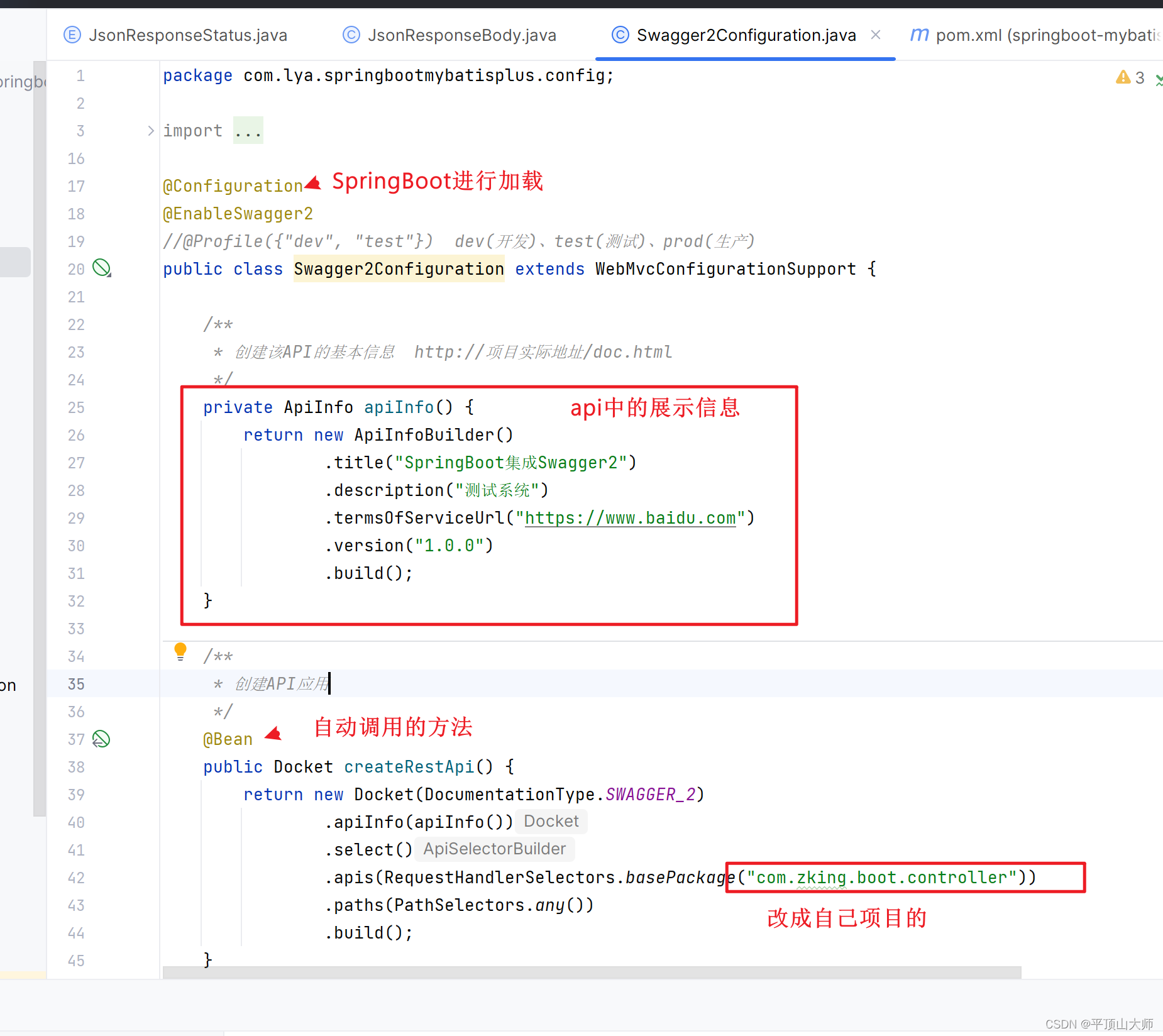
package com.lya.springbootmybatisplus.config; import io.swagger.annotations.ApiOperation; import org.springframework.context.annotation.Bean; import org.springframework.context.annotation.Configuration; import org.springframework.context.annotation.Profile; import org.springframework.web.servlet.config.annotation.ResourceHandlerRegistry; import org.springframework.web.servlet.config.annotation.WebMvcConfigurationSupport; import springfox.documentation.builders.ApiInfoBuilder; import springfox.documentation.builders.PathSelectors; import springfox.documentation.builders.RequestHandlerSelectors; import springfox.documentation.service.ApiInfo; import springfox.documentation.spi.DocumentationType; import springfox.documentation.spring.web.plugins.Docket; import springfox.documentation.swagger2.annotations.EnableSwagger2; @Configuration @EnableSwagger2 //@Profile({"dev", "test"}) dev(开发)、test(测试)、prod(生产) public class Swagger2Configuration extends WebMvcConfigurationSupport { /** * 创建该API的基本信息 http://项目实际地址/doc.html */ private ApiInfo apiInfo() { return new ApiInfoBuilder() .title("SpringBoot集成Swagger2") .description("测试系统") .termsOfServiceUrl("https://www.baidu.com") .version("1.0.0") .build(); } /** * 创建API应用 */ @Bean public Docket createRestApi() { return new Docket(DocumentationType.SWAGGER_2) .apiInfo(apiInfo()) .select() .apis(RequestHandlerSelectors.basePackage("com.zking.boot.controller")) .paths(PathSelectors.any()) .build(); } @Override protected void addResourceHandlers(ResourceHandlerRegistry registry) { registry.addResourceHandler("doc.html").addResourceLocations("classpath:/META-INF/resources/"); registry.addResourceHandler("/webjars/**").addResourceLocations("classpath:/META-INF/resources/webjars/"); } }
2.2、数据回显格式
JsonResponseBody.java
package com.lya.springbootmybatisplus.resp;
import io.swagger.annotations.ApiModel;
import io.swagger.annotations.ApiModelProperty;
import lombok.Data;
@Data
@ApiModel("响应对象")
public class JsonResponseBody<T> {
@ApiModelProperty("响应码")
private Integer code;
@ApiModelProperty("响应信息")
private String msg;
@ApiModelProperty("响应数据")
private T data;
@ApiModelProperty("响应条数(用于分页)")
private Long total;
private JsonResponseBody(JsonResponseStatus jsonResponseStatus, T data) {
this.code = jsonResponseStatus.getCode();
this.msg = jsonResponseStatus.getMsg();
this.data = data;
}
private JsonResponseBody(JsonResponseStatus jsonResponseStatus, T data, Long total) {
this.code = jsonResponseStatus.getCode();
this.msg = jsonResponseStatus.getMsg();
this.data = data;
this.total = total;
}
public static <T> JsonResponseBody<T> success() {
return new JsonResponseBody<T>(JsonResponseStatus.OK, null);
}
public static <T> JsonResponseBody<T> success(T data) {
return new JsonResponseBody<T>(JsonResponseStatus.OK, data);
}
public static <T> JsonResponseBody<T> success(T data, Long total) {
return new JsonResponseBody<T>(JsonResponseStatus.OK, data, total);
}
public static <T> JsonResponseBody<T> unknown() {
return new JsonResponseBody<T>(JsonResponseStatus.UN_KNOWN, null);
}
public static <T> JsonResponseBody<T> other(JsonResponseStatus jsonResponseStatus) {
return new JsonResponseBody<T>(jsonResponseStatus, null);
}
}
JsonResponseStatus.java
package com.lya.springbootmybatisplus.resp;
import lombok.Getter;
@Getter
public enum JsonResponseStatus {
OK(200, "OK"),
UN_KNOWN(500, "未知错误"),
RESULT_EMPTY(1000, "查询结果为空!"),
;
private final Integer code;
private final String msg;
JsonResponseStatus(Integer code, String msg) {
this.code = code;
this.msg = msg;
}
}
3. 初步的访问swagger网址
? ? ? ? 启动项目,项目默认访问路径+/doc.html即可

4. 第三方工具引入接口?
放入这个地址:
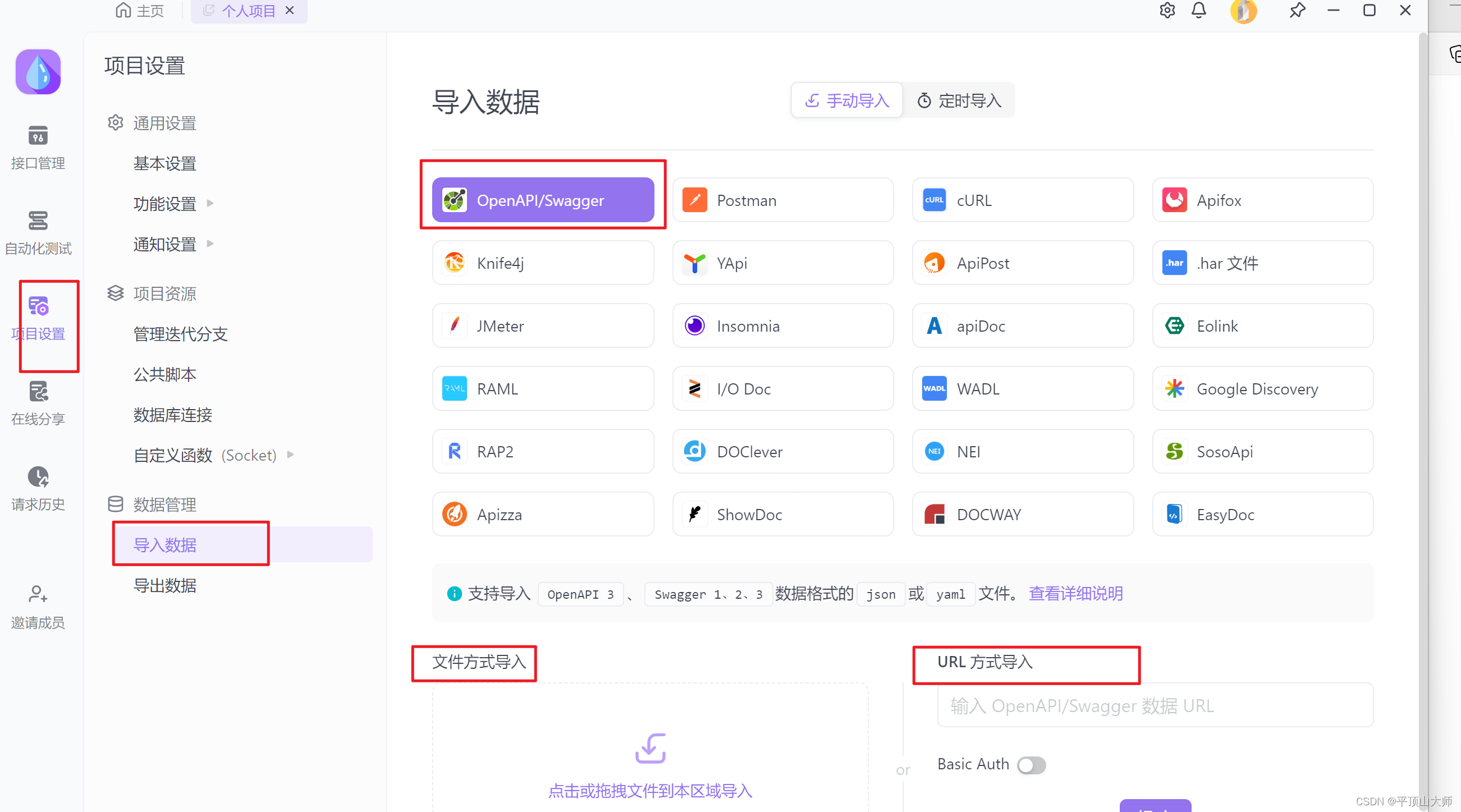
就会加载项目:
四、swagger基本使用
@Api
@Api注解用在类上,说明该类的作用。可以标记一个Controller类做为swagger文档资源。
| 属性 | 说明 |
|---|---|
| value | url的路径值 |
| tags | 如果设置这个值、value的值会被覆盖 |
| produces | 返回的格式类型例如:"application/json, application/xml" |
| consumes | 接收请求参数的类型例如:"application/json, application/xml" |
| protocols | Possible values: http, https, ws, wss. |
| authorizations | 高级特性认证时配置 |
案例演示
@RestController
@Api(value = "书本管理",tags = {"书本管理"}) //tags可以代替value属性
@RequestMapping("/book")
public class BookController {
? ...
}
@ApiOperation
@ApiOperation注解用在方法上,说明方法的作用,每一个url资源的定义。
| 属性 | 说明 |
|---|---|
| value | url的路径值 |
| tags | 如果设置这个值、value的值会被覆盖 |
| produces | 返回的格式类型例如:"application/json, application/xml" |
| consumes | 接收请求参数的类型例如:"application/json, application/xml" |
| hidden | 是否在文档中显示 |
| notes | 注释说明 |
| response | 返回的对象 |
| responseContainer | 这些对象是有效的 "List", "Set" or "Map".,其他无效 |
| responseReference | 指定对响应类型的引用。指定的引用可以是本地的,也可以是远程的*将按原样使用,并覆盖任何指定的response()类 |
| responseHeaders | 响应旁边提供的可能标题列表 |
| httpMethod | "GET", "HEAD", "POST", "PUT", "DELETE", "OPTIONS" and "PATCH" |
| code | http的状态码 默认 200 |
案例演示
@ApiOperation(value = "查询所有书本信息", notes = "查询返回所有书本信息集合",
? ? ? ? ? ?produces = "application/json")
@GetMapping(value="/queryAll")
public JsonResponseBody<List<Book>> queryAll(){
? ?try {
? ? ? ?return bookService.queryAll();
? } catch (Exception e) {
? ? ? ?e.printStackTrace();
? ? ? ?return new JsonResponseBody<>(500,e.getMessage());
? }
}

@ApiImplicitParam
@ApilmplicitParam 注解用来描述一个参数,可以配置参数的中文含义,也可以给参数设置默认值,这样在接口测试的时候可以避免手动输入;
| 属性 | 说明 |
|---|---|
| paramType | 参数放在哪个地方 |
| name | 参数名称 |
| value | 参数代表的含义 |
| dataType | 参数类型 |
| dataTypeClass | 参数类型 |
| required | 是否必要 |
| defaultValue | 参数的默认值 |
paramType
| 类型 | 作用 |
|---|---|
| path | 以地址的形式提交数据,用于restful接口。请求参数采用@PathVariable获取 |
| query | 直接跟参数完成自动映射赋值。请求参数可采用@RequestParam获取 |
| body | 以流的形式提交,仅支持POST。请求参数采用@RequestBody获取 |
| header | 参数在request headers里边提交。请求参数采用@RequestHeader获取 |
| form | 以form表单的形式提交,仅支持POST。 |
案例演示
@ApiOperation(value="查询单个书本信息",notes = "查询单个书本信息")
@ApiImplicitParam(value="书本ID",name="bookid",required = true,dataType = "String",defaultValue = "8f46b5018a6811e9a9c528d24413c293" )
@GetMapping("/querySingleBook")
public Book querySingleBook(String bookid){
? ?JsonResponseBody<Book> json = bookService.selectByPrimaryKey(bookid);
? ?return json.getData();
}
@ApiImplicitParams
@ApilmplicitParams 如果有多个参数,则需要使用多个 @ApilmplicitParam 注解来描述, 多个 @ApilmplicitParam 注解需要放在一个 @ApilmplicitParams 注解中;
案例演示
@ApiOperation(value = "新增书本信息", notes = "新增书本信息"
? ? ? ? ? ,produces = "application/json",consumes = "application/json")
@ApiImplicitParams({
? ? ? ? ? ?@ApiImplicitParam(name="bookname",value="书本名称",required = true,dataType = "String"),
? ? ? ? ? ?@ApiImplicitParam(name="price",value="书本价格",required = true,dataType = "Double"),
? ? ? ? ? ?@ApiImplicitParam(name="booktype",value="书本类型",required = true,dataType = "String")
})
@PostMapping("/addBook")
public JsonResponseBody<?> addBook(@RequestParam String bookname,
? ? ? ? ? ? ? ? ? ? ? ? ? ? ? ? ? @RequestParam Double price,
? ? ? ? ? ? ? ? ? ? ? ? ? ? ? ? ? @RequestParam String booktype){
? ?return bookService.insert(Book.builder()
? ? ? .bookid(UUID.randomUUID().toString().replace("-",""))
? ? ? .bookname(bookname)
? ? ? .booktype(booktype)
? ? ? .price(price)
? ? ? .build());
}
@ApiModel和@ApiModelProperty
@ApiModel注解描述一个Model的信息(这种一般用在post创建的时候,使用@RequestBody这样的场景,请求参数无法使用 @ApiImplicitParam注解进行描述的时候;
@ApiModelProperty注解描述一个model的属性。
| 属性 | 说明 |
|---|---|
| value | 字段说明 |
| name | 参数名称 |
| dataType | 参数类型 |
| hidden | 在文档中隐藏 |
| required | 是否必要 |
| example | 举例说明 |
| notes | 注释说明 |
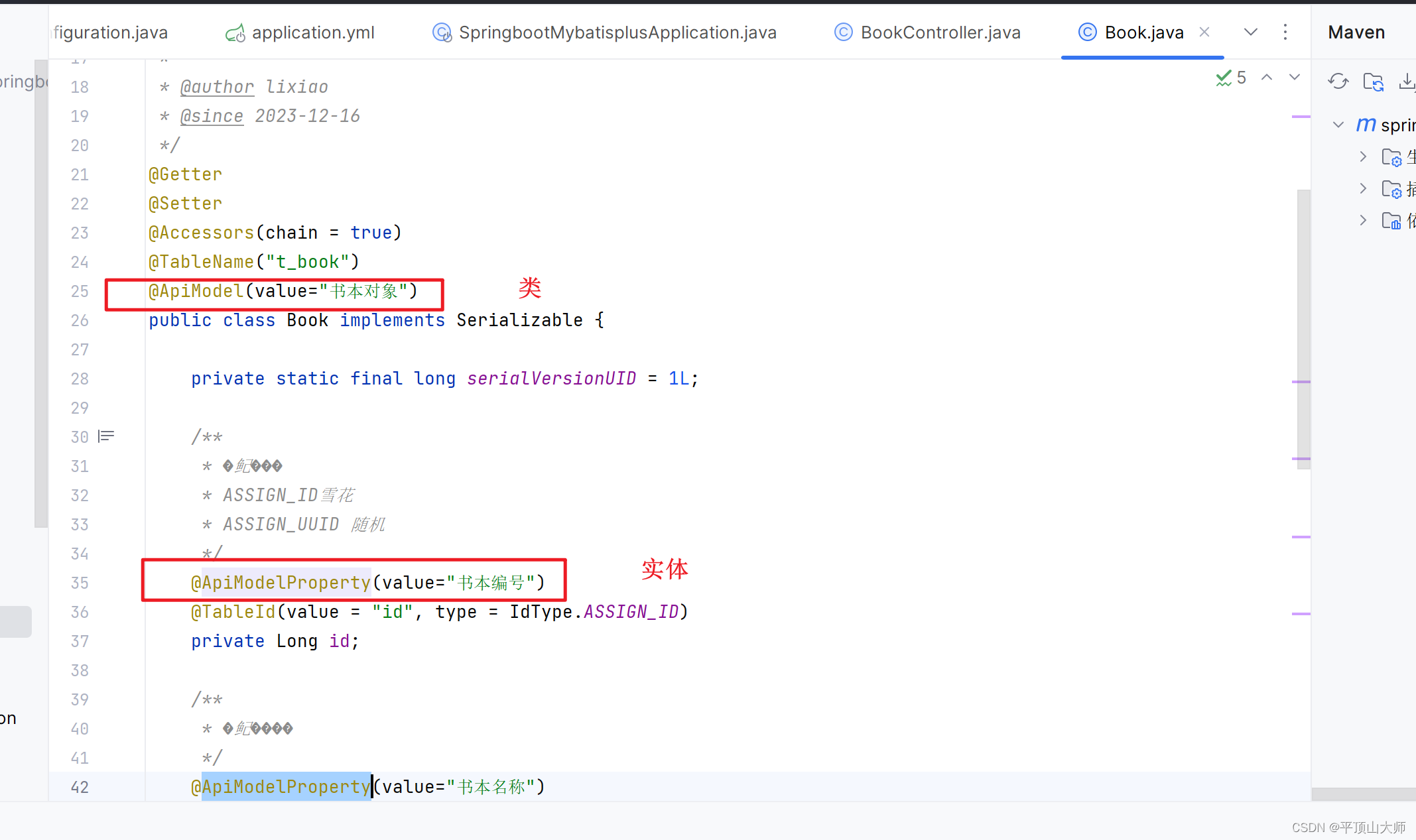
案例演示
Controller
@ApiOperation(value="修改书本信息",notes = "修改书本信息")
@PostMapping("/editBook")
public JsonResponseBody<?> editBook(@RequestBody Book book){
? ?return bookService.updateByPrimaryKey(book);
}
注意:在这里可以不使用@ApiImplicitParam标注Swagger中的参数信息,因为在这里的输入参数是实体对象,而在实体对象中已经使用@ApiModel和@ApiModelProperty注解进行了标识。
Book实体类
@Data
@Builder
@AllArgsConstructor
@NoArgsConstructor
@ApiModel(value="书本对象")
public class Book implements Serializable {
?
? ?/**
? ? * 书本编号
? ? */
? ?@ApiModelProperty(value="书本编号")
? ?private String bookid;
?
? ?/**
? ? * 书本名称
? ? */
? ?@ApiModelProperty(value="书本名称")
? ?private String bookname;
?
? ?/**
? ? * 书本价格
? ? */
? ?@ApiModelProperty(value="书本价格")
? ?private Double price;
?
? ?/**
? ? * 书本类型
? ? */
? ?@ApiModelProperty(value="书本类型")
? ?private String booktype;
?
? ?private static final long serialVersionUID = 1L;
}
package com.lya.springbootmybatisplus.pojo; import com.baomidou.mybatisplus.annotation.*; import java.io.Serializable; import io.swagger.annotations.ApiModel; import io.swagger.annotations.ApiModelProperty; import jdk.internal.org.objectweb.asm.Handle; import lombok.Getter; import lombok.Setter; import lombok.experimental.Accessors; /** * <p> * �鱾��?�� * </p> * * @author lixiao * @since 2023-12-16 */ @Getter @Setter @Accessors(chain = true) @TableName("t_book") @ApiModel(value="书本对象") public class Book implements Serializable { private static final long serialVersionUID = 1L; /** * �鱾��� * ASSIGN_ID雪花 * ASSIGN_UUID 随机 */ @ApiModelProperty(value="书本编号") @TableId(value = "id", type = IdType.ASSIGN_ID) private Long id; /** * �鱾���� */ @ApiModelProperty(value="书本名称") @TableField("bookname") private String bookname; /** * �鱾�?� */ @ApiModelProperty(value="书本价格") @TableField(value = "price",fill = FieldFill.INSERT_UPDATE) private Float price; /** * �鱾���� */ @ApiModelProperty(value="书本类型") @TableField(value = "booktype",fill = FieldFill.INSERT_UPDATE) private String booktype; @ApiModelProperty(hidden = true) @TableLogic //逻辑删除 private Integer statu; @ApiModelProperty(hidden = true) @Version private Integer version; }

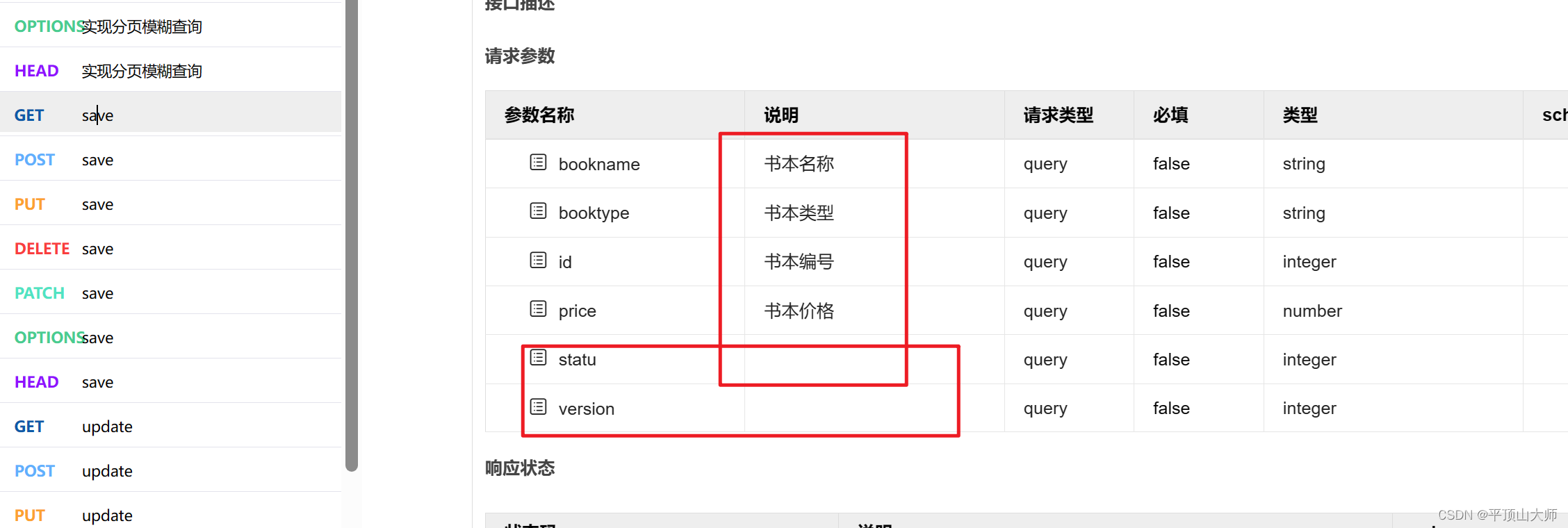
@ApiParam
作用在方法的参数上,用来描述接口的参数信息(一个参设置一个)
@ApiParam必须与@RequestParam、@PathVariable和@RequestHeader一起使用。
| 属性 | 说明 |
|---|---|
| name | 参数名称 |
| value | 参数简单描述 |
| defaultValue | 描述参数默认值 |
| required | 是否为必传参数, false:非必传; true:必传 |
| allowMultiple | 指定参数是否可以通过多次出现来接收多个值 |
| hidden | 隐藏参数列表中的参数 |
| example | 非请求体(body)类型的单个参数示例 |
| examples | @Example(value = @ExampleProperty(mediaType = “”, value = “”)) 参数示例,仅适用于请求体类型的请求 |
案例演示
@ApiOperation(value="新增书本信息1",notes="新增书本信息1")
@PostMapping("/addBooks")
public JsonResponseBody<?> addBooks(
? ? ? ? ? ?@ApiParam(name="bookName",value="bookName",required = true) @RequestParam("bookName") String bookName,
? ? ? ? ? ?@ApiParam(name="price",value="price",required = true) @RequestParam("price") float price,
? ? ? ? ? ?@ApiParam(name="bookType",value="bookType",required = true) @RequestParam("bookType") String bookType){
? ? ?System.out.println("bookName="+bookName+",price="+price+",bookType="+bookType);
? ?return new JsonResponseBody<>();
}
5.生产环境下屏蔽Swagger2
打jar包

运行jar
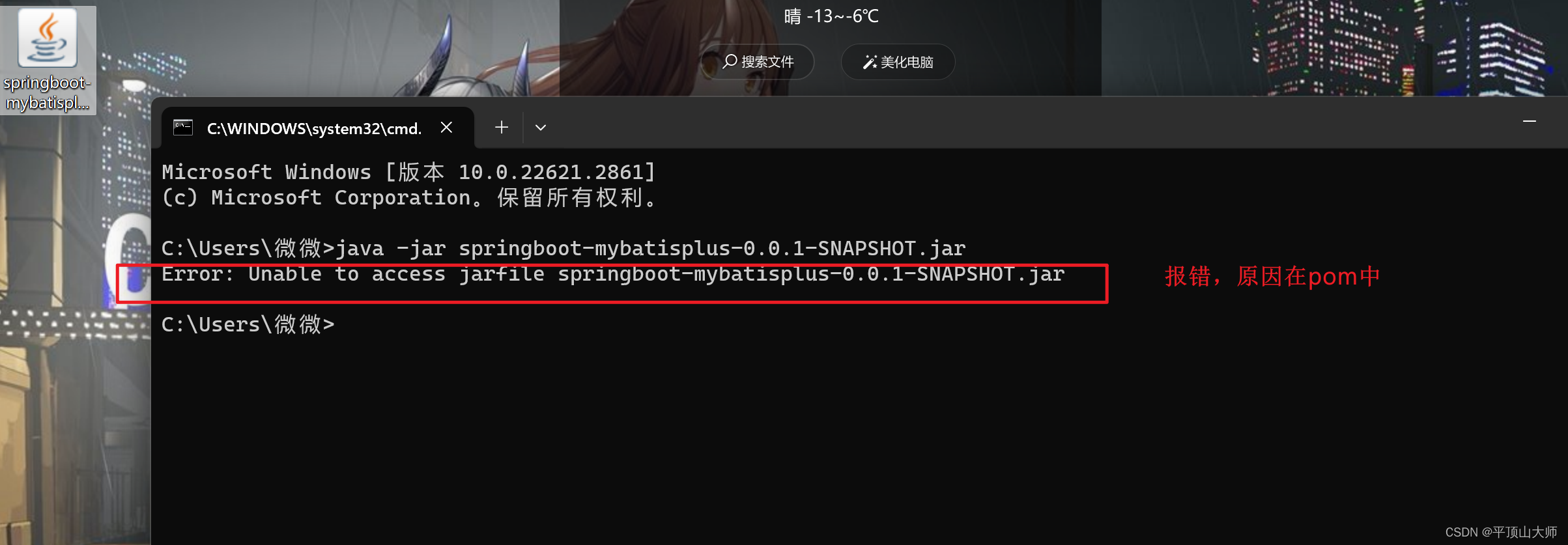
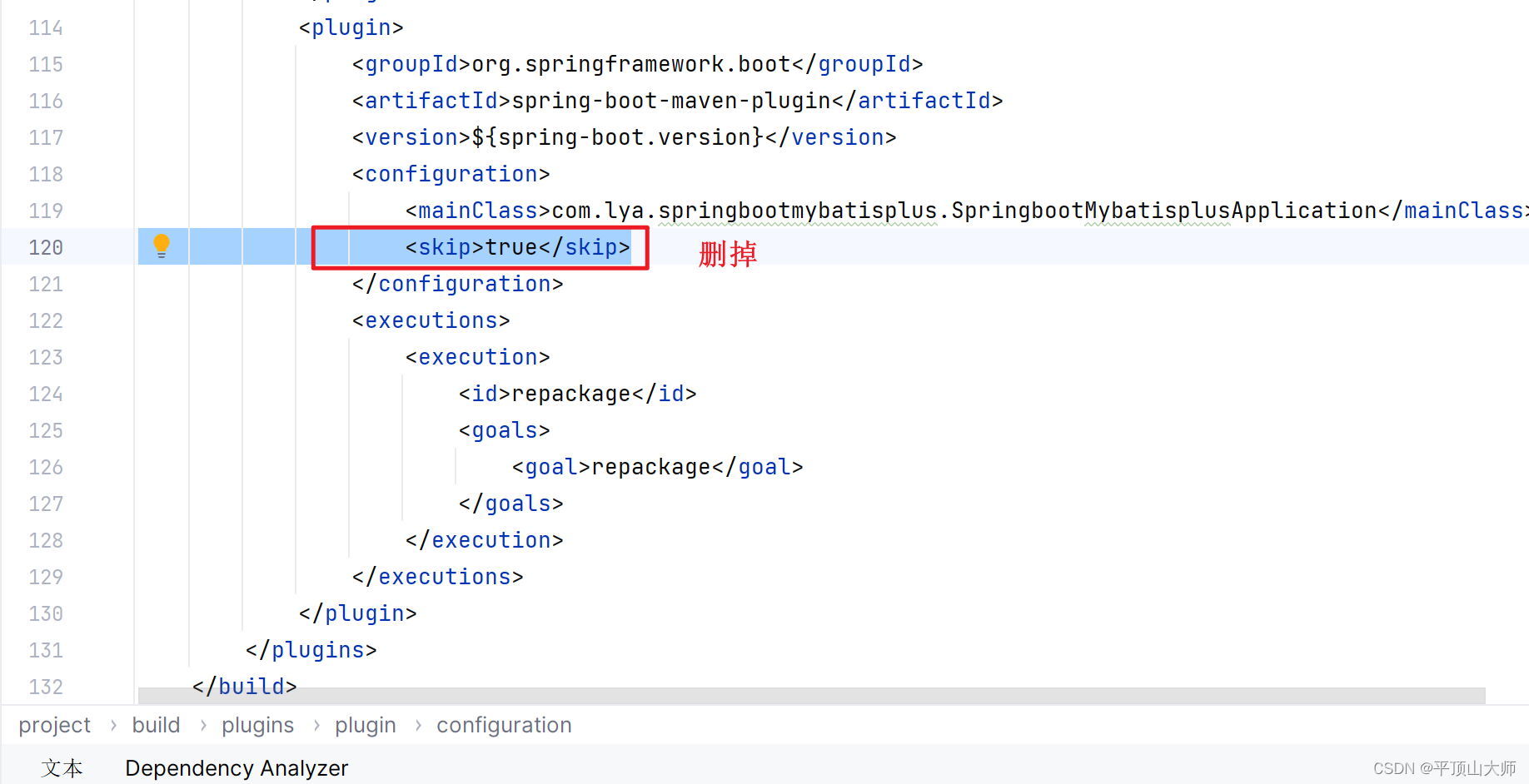
为了保证接口文档的安全,禁用了生产环境的加载,具体说明请看:
一般生产环境是不能放开swagger的,这样接口暴露在外网很不安全!!!
一般生产环境是不能放开swagger的,这样接口暴露在外网很不安全!!!
一般生产环境是不能放开swagger的,这样接口暴露在外网很不安全!!!
5.1.修改Swagger2配置类
添加@Profile注解,指明在何种环境下可以使用Swagger2,一般情况下只有在开发(dev)和测试(test)环境下才可以使用Swagger2;而在生产(dev)环境下不能使用Swagger2。
@Configuration
//开启Swagger2
@EnableSwagger2
//配置生产环境下不可用 dev(开发)、test(测试)、prod(生产)
@Profile({"dev","test"})
public class Swagger2Configuration extends WebMvcConfigurationSupport {
? ?
? ...
?
? ?@Override
? ?protected void addResourceHandlers(ResourceHandlerRegistry registry) {
? ? ? ?registry.addResourceHandler("doc.html")
.addResourceLocations("classpath:/META-INF/resources/");
? ? ? ?registry.addResourceHandler("/webjars/**")
.addResourceLocations("classpath:/META-INF/resources/webjars/");
? }
}
5.2.修改application.yml
修改application.yml文件,配置项目系统的运行环境(dev/test/prod)
spring: ?#配置swagger2生产和测试环境不可用 profiles: ? active: prod
5.3.使用maven package打包测试
5.4.运行测试
打开CMD,跳转到target目录,输入命令:java -jar .\xxx.jar --spring.profiles.active=prod。可以直接打开jar包修改application.yml配置文件中spring.profiles.active属性切换运行环境,具体请参考以下配置:
开发环境:dev; 生产环境:prod; 测试环境:test;
? ? ? 运行命令:?java -jar .\yxbook-0.0.1-SNAPSHOT.jar --spring.profiles.active=环境
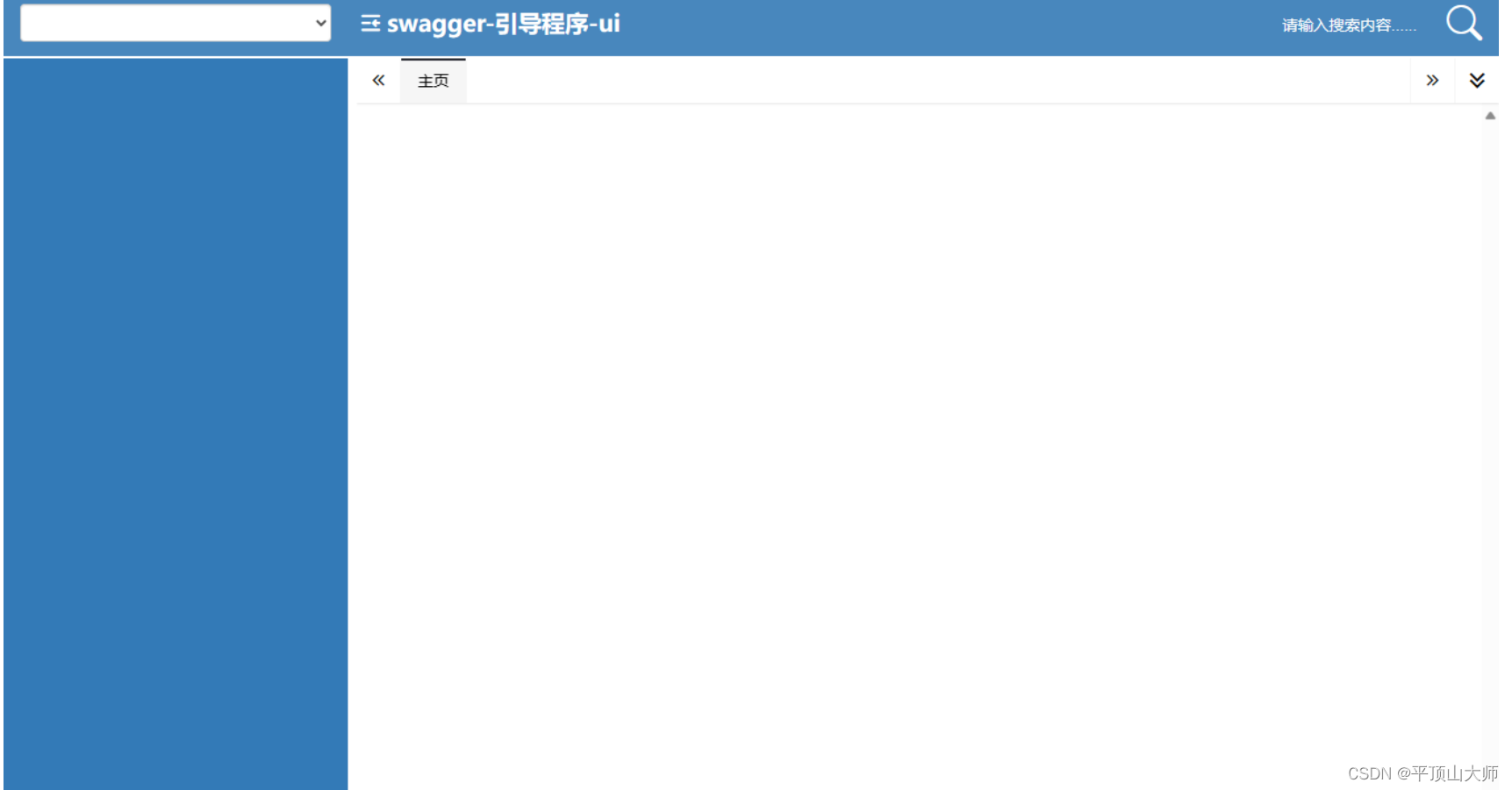

本文来自互联网用户投稿,该文观点仅代表作者本人,不代表本站立场。本站仅提供信息存储空间服务,不拥有所有权,不承担相关法律责任。 如若内容造成侵权/违法违规/事实不符,请联系我的编程经验分享网邮箱:chenni525@qq.com进行投诉反馈,一经查实,立即删除!
